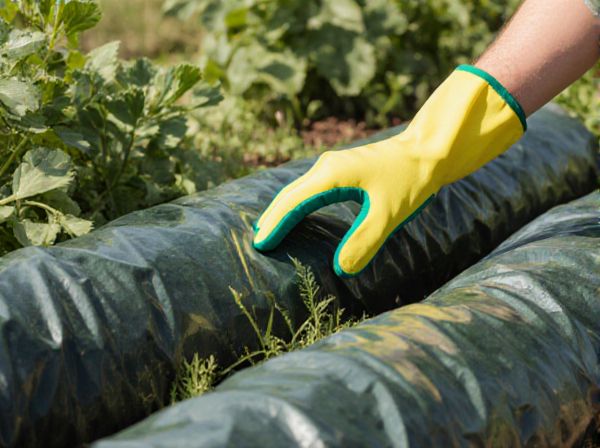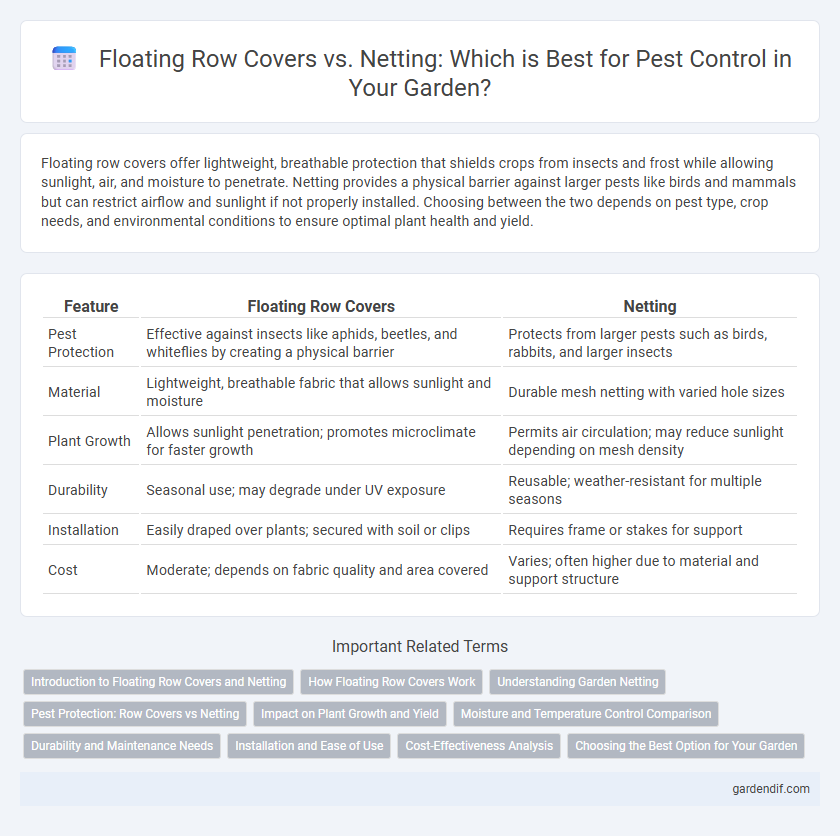
Floating row covers vs Netting Illustration
Floating row covers offer lightweight, breathable protection that shields crops from insects and frost while allowing sunlight, air, and moisture to penetrate. Netting provides a physical barrier against larger pests like birds and mammals but can restrict airflow and sunlight if not properly installed. Choosing between the two depends on pest type, crop needs, and environmental conditions to ensure optimal plant health and yield.
Table of Comparison
| Feature | Floating Row Covers | Netting |
|---|---|---|
| Pest Protection | Effective against insects like aphids, beetles, and whiteflies by creating a physical barrier | Protects from larger pests such as birds, rabbits, and larger insects |
| Material | Lightweight, breathable fabric that allows sunlight and moisture | Durable mesh netting with varied hole sizes |
| Plant Growth | Allows sunlight penetration; promotes microclimate for faster growth | Permits air circulation; may reduce sunlight depending on mesh density |
| Durability | Seasonal use; may degrade under UV exposure | Reusable; weather-resistant for multiple seasons |
| Installation | Easily draped over plants; secured with soil or clips | Requires frame or stakes for support |
| Cost | Moderate; depends on fabric quality and area covered | Varies; often higher due to material and support structure |
Introduction to Floating Row Covers and Netting
Floating row covers and netting are essential tools in integrated pest management for protecting crops from insects, birds, and environmental stressors. Floating row covers, made from lightweight, permeable fabric, allow sunlight, air, and moisture to reach plants while creating a physical barrier against pests. In contrast, netting offers a more durable, reusable solution that provides protection against larger pests and birds while enabling airflow and light penetration to promote healthy plant growth.
How Floating Row Covers Work
Floating row covers create a physical barrier that prevents pests like aphids, beetles, and caterpillars from reaching plants by draping lightweight fabric directly over crops, allowing sunlight, air, and moisture to penetrate while blocking insects. The covers work by interfering with pest access and oviposition, reducing the likelihood of infestations and decreasing the need for chemical pesticides. This method is especially effective for protecting vulnerable vegetables and fruits during critical growth stages.
Understanding Garden Netting
Garden netting provides effective pest control by creating a physical barrier that prevents insects and birds from damaging plants while allowing air, light, and moisture to reach the crops. Different types of netting materials, such as polyethylene and nylon, offer various levels of durability and mesh sizes tailored to specific pest threats and plant requirements. Proper installation of garden netting ensures ventilation and accessibility, promoting healthy plant growth and long-term pest management.
Pest Protection: Row Covers vs Netting
Floating row covers provide a physical barrier that effectively blocks a wide range of insect pests such as aphids, cabbage worms, and beetles, preventing direct contact with plants while allowing light and moisture to penetrate. Netting offers pest protection primarily against larger insects and birds but may allow smaller pests like aphids to pass through due to its larger mesh size. Optimal pest management often involves selecting floating row covers for comprehensive insect exclusion and netting when targeting larger pests or bird protection.
Impact on Plant Growth and Yield
Floating row covers create a microclimate that enhances temperature and humidity levels, promoting faster plant growth and higher yields by protecting crops from pests without obstructing sunlight or airflow. In contrast, netting offers robust physical protection against larger pests but may shade plants and restrict airflow, potentially reducing photosynthesis and slightly hindering growth and yield. Optimal choice depends on balancing pest protection with maintaining adequate light and ventilation to maximize crop production.
Moisture and Temperature Control Comparison
Floating row covers offer superior moisture retention by creating a microclimate that reduces evaporation and conserves soil moisture, contributing to consistent plant hydration. Netting, with its open weave, allows better airflow and temperature regulation but provides less control over humidity levels, often resulting in drier conditions beneath the cover. Optimizing moisture and temperature control depends on specific crop needs, with floating row covers favored for moisture-sensitive plants and netting preferred for those requiring enhanced air circulation.
Durability and Maintenance Needs
Floating row covers offer moderate durability, typically lasting one to two growing seasons before needing replacement, and require minimal maintenance such as occasional securing to prevent wind damage. Netting is generally more durable, with materials like polyethylene providing multi-year use, but often demands careful installation and regular inspections to prevent insect entry and physical damage. Maintenance for netting can be more labor-intensive due to the need for repairs and cleaning, whereas floating row covers are easier to handle but less robust against environmental stress.
Installation and Ease of Use
Floating row covers are lightweight and easy to install directly over plants, requiring minimal support structures, which makes them ideal for quick pest protection and flexible garden layouts. Netting often demands sturdier frames or hoops for proper installation, increasing setup time but providing durable, long-term pest defense. Both options vary in ease of use depending on garden size and the specific pests targeted, with floating row covers more convenient for short-term seasonal use.
Cost-Effectiveness Analysis
Floating row covers offer a cost-effective solution by providing pest protection with lightweight, reusable fabric that reduces the need for chemical pesticides, often lowering overall treatment expenses. Netting typically requires higher initial investment and maintenance costs due to durable materials and installation labor but offers long-term durability and protection against larger pests. Evaluating local pest pressure, crop value, and longevity of materials is critical to determine the most cost-efficient choice between floating row covers and netting.
Choosing the Best Option for Your Garden
Floating row covers offer lightweight, breathable protection against insects and frost, making them ideal for delicate crops needing warmth and moisture retention. Netting provides a durable physical barrier against larger pests like birds and deer, suitable for taller plants and long-term use. Selecting between floating row covers and netting depends on pest type, plant height, and seasonal needs to optimize garden health and yield.
Floating row covers vs Netting Infographic

 gardendif.com
gardendif.com